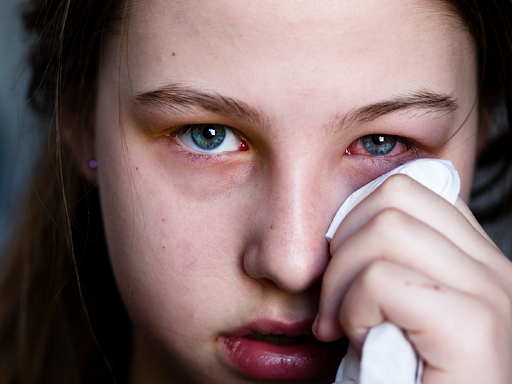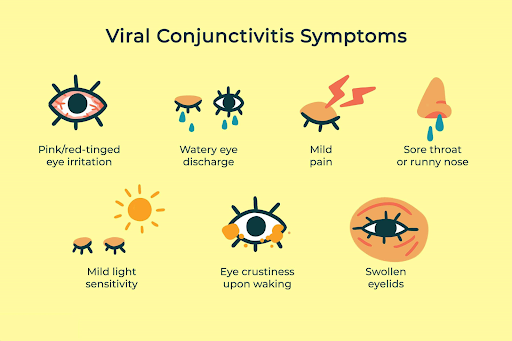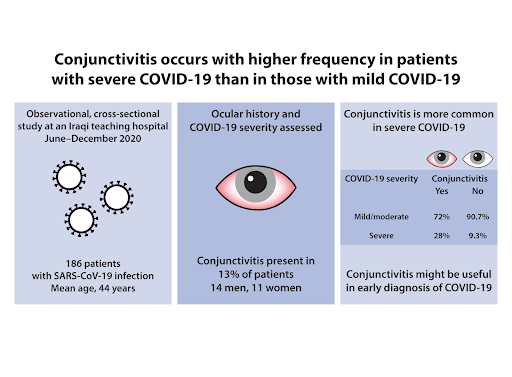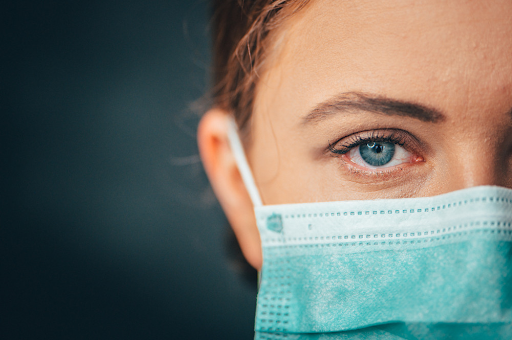Conjunctivitis, and COVID-19

Effect of COVID-19 on Eye: Conjunctivitis (Pink Eye)
Since the beginning of the COVID-19 pandemic in late 2019, there have been more than 6.5 million affirmed instances of the illness around the world. Coronavirus is brought about by a newfound infection called severe acute respiratory condition coronavirus 2 (SARS-CoV-2). The coronavirus family infections cause different respiratory diseases, including the common cold, Middle East respiratory condition (MERS), and serious acute respiratory disorder (SARS).
Some of the common symptoms include fever, coughing, and breathing problems. Sometimes rarely, people also experience an eye infection called conjunctivitis. While it's anything but a common side effect, procuring a disease with the SARS-CoV-2 infection might prompt an individual creating infective conjunctivitis, known as pink eye.
Ophthalmological Symptoms due to COVID-19
The pervasiveness of ophthalmological side effects — which influence the eyes — in individuals with COVID-19 might go from 2-32%. While pink eye is by all accounts one of the more normal ophthalmological side effects, it is still moderately rare, with different sources proposing that it just happens in up to 3% of individuals with the sickness. Research additionally states it is more normal in people with severe instances of COVID-19.
Symptoms of pink eye can include:
- The red or pink color in the white of the eye
- Swelling of the conjunctiva, eyelid, or both
- Irritation, itching, or burning
- Eyelid swelling
- Tearing
- Discharge
- Crusting of eyelids or lashes
- The sensation of a foreign body in the eye
Additionally the conjunctiva, individuals may likewise report side effects in different pieces of the eye, like the optic nerve, retina, understudy, and lacrimal organ. Other eye conditions that might have joined with COVID-19 can include:
- Episcleritis : Alludes to inflammation of the episclera, the thin layer of tissue between the conjunctiva and the sclera. While pink eye has common joins with coronaviruses, case reports note that episcleritis can happen with COVID-19. At times, indications of episcleritis might introduce before the side effects of COVID-19.
- Retinal Changes : The changes to the retina incorporate lesions, cotton wool spots, and bleeding. Different examinations add that COVID-19 can likewise influence retinal veins or result in nodules.
- Optic Neuritis : This alludes to inflammation of the optic nerve, which can influence vision. Coronaviruses can aggravate the optic nerve in creature models, while studies recommend that SARS-CoV-2 might have the capacity to do similar in people.
Conjunctivitis due to COVID-19

The specialists confirmed that around 1%-3% of people with COVID-19 might get conjunctivitis, also called pinkeye. It happens when the infection contaminates a tissue called the conjunctiva, which covers the white piece of your eye or within your eyelids. Side effects incorporate assuming your eyes are:
- Red
- Swollen
- Irritated or itchy
If you have conjunctivitis, it doesn't guarantee to mean you have COVID-19. Conjunctivitis is the side-effect of COVID-19 but is not a symptom of COVID-19. The almost certain causes are a wide range of infections, microbes, synthetic substances, and allergens that can bother your eyes.
Many types of conjunctivitis disappear with over-the-counter medicines in around 1 fourteen days. But, if it is accompanied by fever, cough, or shortness of breath, contact your primary health care specialist. Conjunctivitis itself won't prompt COVID-19 happening in an individual. In any case, if SARS-CoV-2 causes the condition, an individual might proceed to foster COVID-19. While it is an improbable side effect, it could merit thinking that any indications of conjunctivitis could show COVID-19, especially on the off chance that an individual is likewise encountering other more normal side effects of the infection, like fever, cough, or windedness.
How does Conjunctivitis spread

The new coronavirus, named SARS-CoV-2, gets gone on basically through drops from a cough or a sneeze. These particles most frequently enter through your nose or mouth as well as your eyes. It's likewise conceivable to come down with the infection on the off chance that you contact a contaminated ledge, door handle, or different surfaces. In any case, this doesn't appear to be the fundamental way the infection spreads.
Assuming that you have conjunctivitis from COVID-19, you might contaminate others with SARS-CoV-2 on the off chance that you contact your eyes and, contact individuals or surfaces without washing or disinfecting your hands. Try not to touch your face, particularly the mucous membranes in your mouth, nose, and eyes.
You should contact your primary care physician when you experience the below symptoms along with pink eye or different indications of an eye crisis:
- Eye pain or trauma
- Redness or discharge in the eye
- Sudden changes in vision
- Sensitivity to light
For individuals with side effects of pink eye, the CDC prompts treatment with fake tears and cold packs. An individual who wears contacts ought to stop utilizing them until their side effects vanish.
How to Protect Your Eyes

Like everybody, make certain to clean up frequently and remain at home at whatever point you can. If you go out, get 6 feet far from others and wear a cover. It likewise might be smart to:
- Contact Lenses : There is no proof wearing contacts puts you at more gamble for COVID-19 than the individuals who wear eyeglasses. In any case, you ought to keep on pursuing safe cleanliness routines for wearing and focusing on them and cleaning up before placing them in or taking them out.
- Wear glasses : Your glasses' focal points might assist with shielding your eyes from any respiratory beads. If you don't wear glasses, attempt shades. What's more, if you're focusing on somebody sick, wear security glasses or goggles.
- Stock up on eye medicines : Check with your safety net provider to check whether you can reorder glaucoma drops and other fundamental medicines ahead of time. You could get a 3-month supply. Ask your PCP or drug specialist for any assistance.
- Try not to rub your eyes : It very well may be a hard propensity to break. Dampening drops might assist with facilitating irritation. Clean up for 20 seconds when you do it. If you should contact your eyes, utilize a tissue rather than your fingers.
Outlook
Expanding instances of conjunctivitis, or pink eye can happen as a side effect of COVID-19. The pink eye normally gives redness, enlarging, and touchiness of the eye, possible since SARS-CoV-2 and different individuals from the coronavirus family can cause infective conjunctivitis. In any case, while pink eye and other eye side effects can happen, they are not common side effects of COVID-19. Research shows that SARS-CoV-2 can enter the eye through openness to airborne beads from a cough or contacting the eye after contacting a contaminated surface.
An individual can go to lengths to attempt to safeguard their eyes to decrease the gamble of gaining a SARS-CoV-2 contamination. These can incorporate wearing defensive eyewear, keeping actual separation, and not contacting the eyes with unwashed hands.
If you or anyone you know is suffering from the effects of Covid-19, our expert providers at Post Covid Centers will take care of your health and help you recover.
Call us on (469) 545-9983 to book a telehealth appointment for a home check-up.
People Also Read:
Post Covid Syndrome vs. Fatigue
While COVID-19 is a short-lived disease in most people, others experien...
Post Covid Syndrome vs. Skin Weakness Problems
A new study illustrates that some patients with COVID-19 disease have continuous skin-associated symptoms...
RELATED BLOGS
